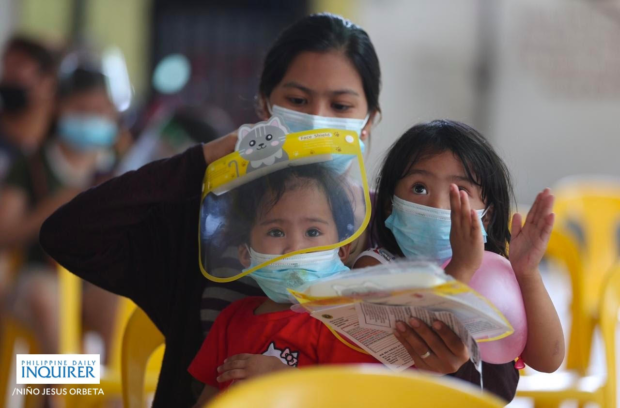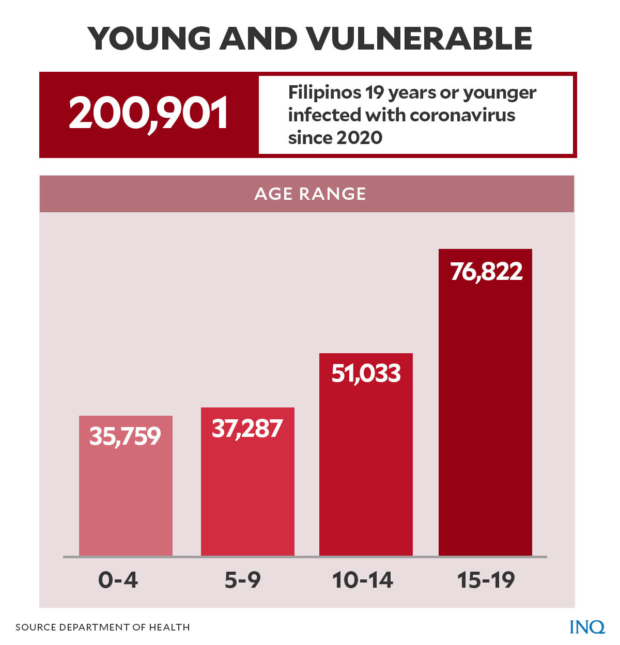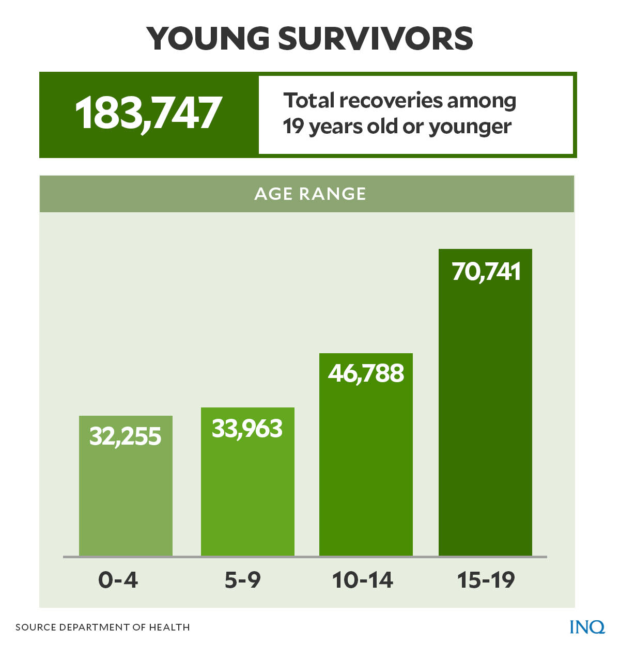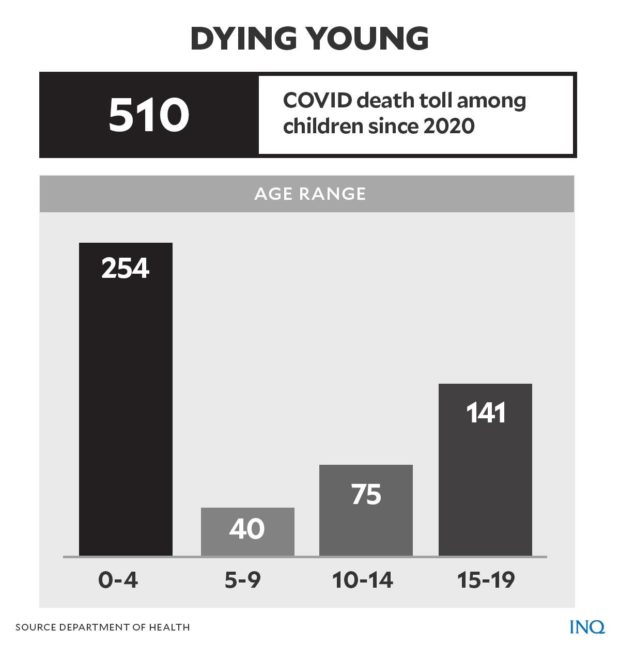Delta: When being young is no longer a protection

FILE PHOTO: The challenge for parents to keep their children safe has grown during the pandemic. NIÑO JESUS ORBETA/INQUIRER
MANILA, Philippines—Recent data on coronavirus infections are belying the previously widespread belief that the young, especially children, were at a lower level of risk.
Numbers available everywhere, including the Philippines, showed that children were increasingly becoming infected especially with Delta, the more contagious variant of SARS Cov2, the virus that causes COVID-19.
The Department of Health (DOH) has not yet declared community transmission of Delta, stressing the need for more evidence.
Health Undersecretary Maria Rosario Vergeire said there were signs of community transmission—infections among individuals who had no known contact with infected persons—in Calabarzon and National Capital Region.
READ: Delta variant community transmission ‘observed’ in NCR, Region 4A — DOH
Despite the absence of a government declaration, however, the group Save the Children Philippines (SCP) said it was seriously concerned about the increase in reported COVID cases among the young—19 years or younger.
READ: PGC results show Delta variant community transmission in PH–DOH
“We can see from the data that cases are rising in the pediatric age group,” said Dr. Kaydee Doloroso. These numbers, she said, should prompt all individuals to heed health protocols against coronavirus infection.
Last week, infectious disease expert Dr. Rontgene Solante said that with the Delta variant being highly contagious, infections will “exempt” no one, even children.
SCP said that while children are not considered part of “high-risk groups” and that most of the young who had been infected with coronavirus get “mild” COVID cases, it was concerned, especially with the Delta variant being “more fatal to children.”
Dr. Cecilia Francisco, of SCP, said the disease puts children at risk, especially those with preexisting health conditions, and those below one-year-old because their immune response was either “compromised or not yet developed.”
READ: COVID-19 infection, deaths in children can be attributed to Delta variant — expert
“Children with COVID-19 generally have milder effects and better prognosis than adults but those who have underlying diseases have higher risks of experiencing severe illnesses,” she said.
According to the DOH last Sunday (Aug. 22), 200,901 young Filipinos aged 19 years old and below got COVID since the pandemic struck in 2020—35,759 (0 to 4 years old), 37,287 (5 to 9 years old), 51,033 (10 to 14 years old) and 76,822 (15 to 19 years old).
The DOH said 183,747 have already recovered—32,255 (0 to 4 years old), 33,963 (5 to 9 years old), 46,788 (10 to 14 years old), and 70,741 (15 to 19 years old).
Since the beginning of the health crisis, 510 children, mostly 4 years old and below, have died because of the disease—254 (0 to 4 years old), 40 (5 to 9 years old), 75 (10 to 14 years old) and 141 (15 to 19 years old).
COVID-19 in children
When asked if COVID-19 cases and deaths involving Filipino children were because of the Delta variant, Solante agreed, saying that “when you have a virus that is highly transmissible than the original strain, then there’s no exception with that, even children who are exposed to adults.”
The US Center for Disease Control and Prevention (CDC) said evidence had shown that, compared to adults, children were likely to have similar viral loads in their nasopharynx and were more likely to transmit the virus to others. In other words, the virus had turned children into most likely carriers.
The virus’ incubation period in children is 2 to 14 days with symptoms that include fever, fatigue, headache, myalgia, cough, nasal congestion, loss of taste or smell, sore throat, shortness of breath or difficulty breathing, abdominal pain, diarrhea, nausea, and poor appetite.
The CDC said that the most common symptoms in children are cough or fever or a combination of those. But for children with existing medical conditions and those aged one year old and below, there is an increased risk for severe illness.
“Similar to adults, children with severe COVID-19 may develop respiratory failure, myocarditis, shock, acute renal failure, coagulopathy, and multi-organ system failure,” said CDC.
“Some children with COVID-19 have developed other serious problems like intussusception or diabetic ketoacidosis,” it said.
It added that children with COVID-19 were also at risk of developing Multisystem Inflammatory Syndrome in Children (MIS-C)—a rare inflammatory condition in children with the disease.
CDC had likened the transmissibility of the Delta variant to chickenpox, which was 90 percent transmissible from an infected person to others.
According to the Philippine Pediatric Society (PPS), 20 percent of children who were hospitalized because of COVID-19 have pre-existing health conditions.
Earlier this month, children sick with COVID-19, especially those with prior illnesses, had become a growing concern at the Philippine General Hospital where three children were said to be in critical condition.
READ: COVID-hit kids are a growing concern at PGH
Case increases
Last Aug. 9, addressing concerns that there was an increase in COVID-19 cases involving children, the DOH said that infections are increasing across all age groups, explaining that from July 29 to Aug. 8, cases increased to 59 percent.
The DOH also presented data from several groups of Philippine doctors last February saying there were at least 48,411 COVID cases among Filipino children.
Last Aug. 8, it reached 176,540 and even increased to 181,593 on Aug. 12, less than a week after a strict lockdown in Metro Manila was imposed.
PPS said that globally, children typically account for 15 percent of “laboratory-confirmed COVID-19 cases.”
Children’s data
Pediatric health experts believe the “actual number” of COVID-19 cases in children could be higher, explaining that there is likely “underreporting of infections.”
With “scarcity in data,” the Pediatric Infectious Disease Society of the Philippines (PIDSP) initiated the “Salvacion Study” to collect “retrospective and prospective data on the epidemiologic profile, clinical and laboratory features, treatment, and outcome of COVID-19 in children through a pediatric COVID-19 registry.”
As of June 30, the Salvacion Study received 1,143 reported cases with children aged 1 to 5 years old having the highest incidence—14.3 percent male and 11.0 percent female.
Its report said that 20.6 percent was asymptomatic, 38.7 percent mild, 24.1 percent moderate, 8.1 percent severe, while 8.5 percent was critical.
The 1,143 reported cases were 91.3 percent children in hospitals and 8.7 percent who stayed inside their houses for isolation.
“We invite all health care providers nationwide to participate in this relevant project by contributing de-identified information on your confirmed or probable pediatric COVID-19 patients aged 0 to 18 years old admitted or managed as outpatients in your institution,” it said.
“The success of this project depends on the collective effort and participation of all healthcare workers caring for children, and we enjoin you to be one with us in this battle we are fighting for the Filipino child,” it added.
Protecting children
Doloroso said based on her experience as a doctor, she believed that parents should be wary and should always heed basic health protocols to protect their children.
“We should take part in protecting them and encourage vaccination in the adult population,” she said.
The PIDSP listed the following reminders to protect children against COVID-19:
• Stay away and get cover when coughing or sneezing
• Avoid bringing children to public and crowded places
• Avoid interacting with too many people
• Places should have proper ventilation
• Try to immediately take a bath after going outside
• Children two years old and above should wear face masks and face shields
• Physical distancing should be observed
• Masks and face shields should be disposed of properly
• When not feeling well, isolate
• When children feel symptoms, immediately inform a doctor
However, for SCP, the greatest protection that can be given to children is for adults to get vaccinated, saying that “the sooner this is done, the greater chances for children and adolescents to rise in the priority list.”
READ: Group urges gov’t to ensure vaccination of children amid rise in COVID-19 cases
TSB
For more news about the novel coronavirus click here.
What you need to know about Coronavirus.
For more information on COVID-19, call the DOH Hotline: (02) 86517800 local 1149/1150.
The Inquirer Foundation supports our healthcare frontliners and is still accepting cash donations to be deposited at Banco de Oro (BDO) current account #007960018860 or donate through PayMaya using this link.


